#mathematical calculation
Explore tagged Tumblr posts
Text
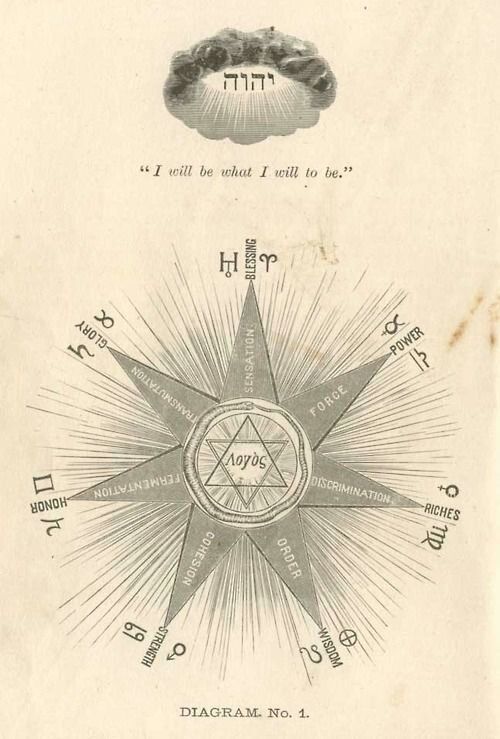
I will be what I will to be
#artists on tumblr#cosmology#symbolism#symbols#I will be what I will to be#diagram#universe#cosmos#structure of the universe#God#world#wisdom#order#alphabet#esoterism#geometry#mathematical calculation#astrology#astronomy
6 notes
·
View notes
Text
y'know, one of the goofiest things I've learnt from the desmos community is that { } with nothing inside equals 1

but that's not just it, you can also add { }s

and it functions just the same as adding 2 1s
but therein lies the funniest part, that you can perform almost any function on it, from minus

to exponents

to even factorials!

and lists too!!!

you can even compare solutions of { }s in { }s

there's almost no restrictions, if you can do it with numbers, you can do it with { }

and this leads me to what I've seen a lot of people calling "desmosfuck" after the infamous programming language brainfuck, and it restricts you by not allowing any letters and no numbers, that includes sin, log, x, y and all the others. The only thing you can make out of { }s are points and numbers though, but thankfully that's usually enough to make a bunch of stuff.
like, if you need π, just use (-0.5)!^2

you need e? you already have π and i, just use e^(iπ)=-1 and rearrange it to e=-1^(1/(iπ)) and get -1^((π^-1)(i^-1))

want phi? sure, just use it's surd representation of (1+sqrt(5))/2

okay, but what if you really wanna do functions? well, if you're desperate, you can sorta do that, you just gotta use a concentration of points.
cos(x) and sin(x)? use the identities

cos seems easier

and x just has to be a dense list of numbers


now that we have x, let us... REWRITE!


that's dense... buuuut, it does the job as soon as we add the x part to the x coordinate!


absolute insanity
you can also get sin by subtracting x by half of pi


awesome
here's tan, btw

go play around with it yourself! it's very silly
834 notes
·
View notes
Text


^description of Chuuya from the Dead Apple light novel. And yet there are still people who try to claim he's stupid
#he's out here doing mathematical calculations in his HEAD#at SIXTEEN#and there are still so many people who insist he's dumb and just the brawn in skk#smh seriously#bungou stray dogs#bungo stray dogs#bsd#bsd chuuya#nakahara chuuya#dead apple#bsd dead apple
210 notes
·
View notes
Text

Messy
#studyblr#study motivation#studyspo#chaotic studyblr#study aesthetic#study blog#studyinspo#chaotic academia#study notes#studyspiration#study#study inspiration#chalk#old school#dark acadamia aesthetic#dark academia#physics#electricity#magnetism#stem academia#stem aesthetic#stem studyblr#stemblr#stem#messy notes#calculations#mathematics
218 notes
·
View notes
Text



Cultural exchange
#reverse 1999#r1999#digital art#fanart#i cant say i am VERY satisfied with this ngl#i just wish my art could look smooth with those smooth brushes but i cannot get used to those for the life of me#so i just used the pencil brush i always use (HB pencil on procreate)#anyways this is an idea ive had for a while and one that had gone through a ton of drafts? to get a good comp?#i was going to draw that but the inside was …it was too hars i gave up on it#talking about the mathematics in nature or something#idk also math in music essentially i remember one of 6’s suitcase dialogue lines involving calculations to produce music#the inside of a nautilus shell looks like a logarithmic curve hence the curve on the drawing#i was going to draw the shell itself but it proved difficult with this brush#idk those big smooth brushes seem ideal for creating a false sense of detail bc the color blocking makes it work#idk if that made much sense…
131 notes
·
View notes
Text
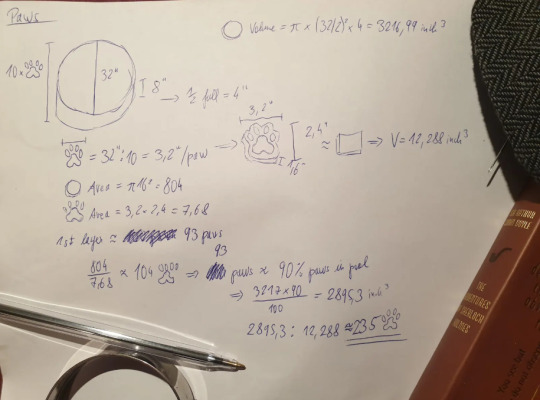
Calculations for that pool challenge thing or whatever its called. For everyone who is too stupid to understand instructions, here you have a visual explanation. Can't be any easier than that. Even with little diagrams.
Use the size of the pool to estimate the size of the paws. About 10 paws fit in the width of the pool, making the estimated length of the paws 3.2 inches. With that size one can calculate width and height of the paw in relation to the length we deduced. Now we need the volume, for that we use a rectangle as an estimation for the paw.
The pool is only half filled, so we calculate the volume of that. Counting the first layer of the pools visible contents, we get 93 paws. We calculate the area of the first layer of the pools contents, and calculating how many paws would cover the whole area, that makes 104 paws. We then use the number of paws we counted, 93, to estimate how much percent of the surface is filled with paws. It's approximately of 90% paws, which we then extrapolate to the whole pools contents. We calculate 90% of the pools volume, and divide it by the paws volume, to deteremine how many paws fit in there.
That gives us 235 paws. With the other available choices for total, crabs and horses, those are my final estimations: 759 total. 235 paws. 247 crabs. 277 horses.
@fandom this is the solution. I know I am right.
#roleplay#sherlock roleplay#rp#johnlock roleplay#sherlock#bbc sherlock#johnlock rp#sherlock holmes#sherlock rp#john watson#sherlock bbc#sherlock fandom#sherlock holmes roleplay#sherlock holmes rp#math#maths posting#mathematics#maths#mathblr#calculations#paws#april fools#picture#boop#tumblr#tumblr april fools#science#math questions#acd holmes#book
22 notes
·
View notes
Text
Uh. So I see a post going around about why you shouldn't rely on ChatGPT for school stuff. And on the one hand, I agree that you should never rely on ChatGPT for maths. But on the other hand, I think there are times when "just use a darn calculator" is not enough.
Hence why I want to introduce a non-AI website/app I used a lot to help me in highschool maths class: Desmos.
You know how, in middle school to highschool, you learn about functions? Equations with multiple variables, where changing one variable will change the other? And then you can make lines on a grid with them? Desmos is specifically for stuff like that!
It's also helpful for trigonometry (sines, cosines, and tangents).
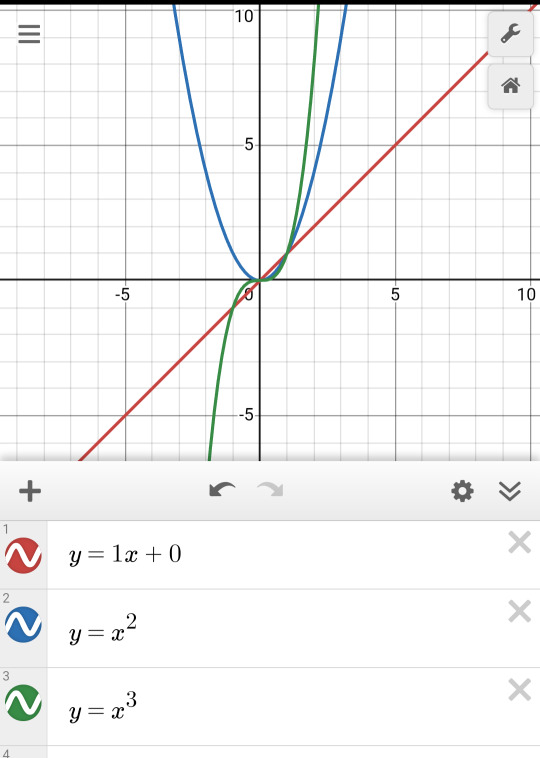
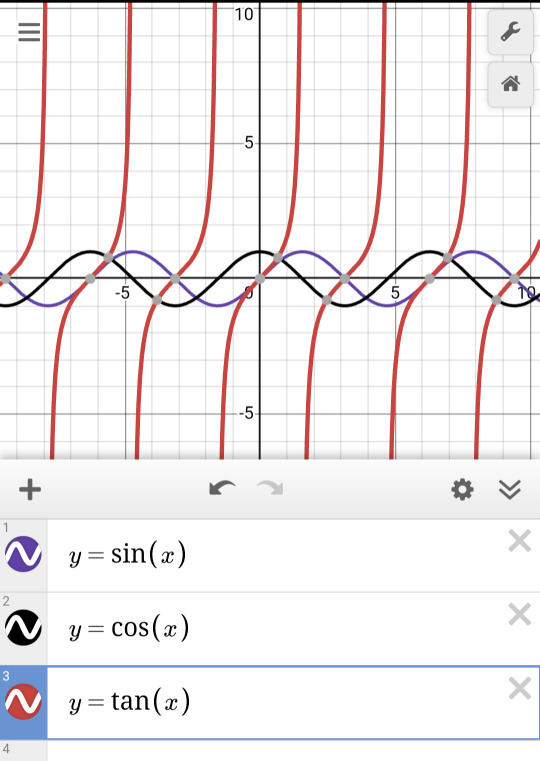
I typed in a few basic functions in the screenshots above. However, if you mess around with the different numbers in the functions, you can get an idea of how that changes things. And if you're more of a visual learner than a listen-to-lectures type, it can be an amazing learning tool. Highly recommend it.
#maths#math#mathematics#my random brain#''but 2030. isn't this still a calculator?''. okay technically it is. but it's a fancy graphing calculator#and it's free! and colour-coded! and very intuitive!#this has been my pro-Desmos propaganda. if you already know Desmos? great. if not? today's your lucky day
95 notes
·
View notes
Text
youtube
#statistics#mathematics#mathblr#math art#calculated risk#calculator#calculus#calculations#cat#black cat#cats#cute cats#kitty cat#cats of tumblr#catblr#kittens#kitten#kitty#kittyposting#cute kitty#natural science#science#mad scientist#data scientist#scientific illustration#research scientist#stem#stem student#stem academia#stemblr
17 notes
·
View notes
Text
as of 2024 the internet is about 149 zettabytes big, for reference one zettabyte is equal to about one trillion gigabytes
one calorie is equal to 2.6 megabytes, and one gigabyte is one thousand megabytes dividing one thousand by 2.6, a gigabyte is about 385 calories multiplying 385 by 149 trillion - 385 x (149 x 1012), we get…
5.7365e+16 calories. in full, this number looks like 57,365,000,000,000,000. 57 quadrillion. wow
but i didn’t want to stop there, i wanted to figure out how many steaks it would take, since steak was the first food that came to mind
a single 100-gram steak is on average 271 calories dividing 5.7365e+16 by 271 gives us 2.1167897e+14 meaning, it would take about 211,678,970,000,000 steaks to eat the internet. 211 trillion.
but, i was wondering, how long would that take?
assuming all 8 billion people on earth are participating, with about a billion chopped off to accommodate those who are unable to eat steak, and each person eats 3 steaks a day
3 x 365 = 1095 1095 x (7 x 109) = 7.665e+12 = 7,665,000,000,000 2.1167897e+14 / 7.665e+12 = 28
that means, if 7 billion people ate 3 steaks every day for 28 years, we would be eating the equivalent of the internet.
i also did other calculations to see how long it would take to eat the internet with different foods
THE INTERNET IS EQUIVALENT TO: 1,147,300,000,000,000 chicken nuggets (if every person ate 30 nuggets per day, it would take 15 years to eat the internet) 124,706,520,000,000 servings of kraft dinner (if every person ate 3 servings per day, it would take 16 years to eat the internet) 194,457,630,000,000 hamburgers (if every person ate 3 burgers per day, it would take 25 years to eat the internet) 2,868,250 grams of uranium (if we fed elon musk 30 grams every day, it would take 262 years to eat the internet)
propriety is dead. eat the internet
tag your homies who you’d eat the internet with
(thank you to @mythbringer-mayhem , @ishankedurmom , and @subparcarrion , who witnessed this buffoonery)
#shitpost#mathematical shitpost#mathematics#if any of the calculations are wrong pls tell me#its my first time calculating something like this#ultimatesoupdemon
20 notes
·
View notes
Text

From The Department of Education Files
#math#mathematics#mathblr#calculus#calculator#dept of education#texas instruments#calculations#math homework#math humor#math help#math hour#school work#high school#college#academics#college life#education#we don't need no education#knowledge#learning#opportunity#1+2
10 notes
·
View notes
Text

DESMOS GOT AN UPDATE?!?!?!

OH HELL YEAAAH
They made a pun about the unimaginable ways we'll use complex numbers....

new circle :o

I've waited for this day since forever
People were doing complex numbers in desmos before, but damn, did not think it could be made so much easier

New error, btw


I know Christmas is two months away, but I feel like it's already started :D
276 notes
·
View notes
Text
so.
if bf is 7 foot tall and gf is 900 pounds
with skyblue being 2 bfs tall and quite a bit curvier than gf, this would mean she weighs about a ton
now this may seem ridiculous, BUT
if we take the average us female height and weight over the age of 20, those being 170.8 pounds and 63.5 inches (around 5'4)
by dividing skyblue's height with the average height we get a scaling factor of 2.59, and by employing the square-cube law we multiply the average weight with the cube of the scaling factor
which equals to *drumroll*
2967.47 pounds!!!
therefore, skyblue's approximate weight is 1.32 imperial tons/1.35 metric tonnes/1.48 us tons
this means that she is heavier than the average giraffe (1 tonne) while also being almost as tall as one (16'9), and only 452.53 pounds lighter than the curb weight of the heaviest toyota camry xv50 model (3420 pounds; SE V6 trim)
#fnf#friday night funkin#fnf au#skyverse#skyblue#fnf bf#fnf gf#fnf boyfriend#fnf girlfriend#fnf sky#important calculations#math#mathematics#guesstimate#calculus#math shitpost#math posting#autism#neurodivergent#aspergers#autism spectrum disorder#autism spectrum condition#autism special interest#autism speaks#actually autistic#actually neurodivergent#I forgot literally everything since high school#I had to look so much shit up for this#the things I do for a shitpost...#I did not sleep last night
12 notes
·
View notes
Text
Names for the number 0 in English
"Zero" is the usual name for the number 0 in English. In British English "nought" is also used and in American English "naught" is used occasionally for zero, but (as with British English) "naught" is more often used as an archaic word for nothing. "Nil", "love", and "duck" are used by different sports for scores of zero.
There is a need to maintain an explicit distinction between digit zero and letter O,[a] which, because they are both usually represented in English orthography (and indeed most orthographies that use Latin script and Arabic numerals) with a simple circle or oval, have a centuries-long history of being frequently conflated. However, in spoken English, the number 0 is often read as the letter "o" ("oh"). For example, when dictating a telephone number, the series of digits "1070" may be spoken as "one zero seven zero" or as "one oh seven oh", even though the letter "O" on the telephone keypad in fact corresponds to the digit 6.
In certain contexts, zero and nothing are interchangeable, as is "null". Sporting terms are sometimes used as slang terms for zero, as are "nada", "zilch" and "zip".
Zero" and "cipher"
"Zero" and "cipher" are both names for the number 0, but the use of "cipher" for the number is rare and only used in very formal literary English today (with "cipher" more often referring to cryptographic cyphers). The terms are doublets, which means they have entered the language through different routes but have the same etymological root, which is the Arabic "صفر" (which transliterates as "sifr"). Via Italian this became "zefiro" and thence "zero" in modern English, Portuguese, French, Catalan, Romanian and Italian ("cero" in Spanish). But via Spanish it became "cifra" and thence "cifre" in Old French, "cifră" in Romanian and "cipher" in modern English (and "chiffre" in modern French).
"Zero" is more commonly used in mathematics and science, whereas "cipher" is used only in a literary style. Both also have other connotations. One may refer to a person as being a "social cipher", but would name them "Mr. Zero", for example.
In his discussion of "naught" and "nought" in Modern English Usage, H. W. Fowler uses "cipher" to name the number 0.
O" ("oh")
In spoken English, the number 0 is often read as the letter "o", often spelled oh. This is especially the case when the digit occurs within a list of other digits. While one might say that "a million is expressed in base ten as a one followed by six zeroes", the series of digits "1070" can be read as "one zero seven zero", or "one oh seven oh". This is particularly true of telephone numbers (for example 867-5309, which can be said as "eight-six-seven-five-three-oh-nine"). Another example is James Bond's designation, 007, which is always read as "double-o seven", not "double-zero seven", "zero-zero seven", or "o o seven".
The letter "o" ("oh") is also used in spoken English as the name of the number 0 when saying times in the 24-hour clock, particularly in English used by both British and American military forces. Thus 16:05 is "sixteen oh five", and 08:30 is "oh eight thirty".
The use of O as a number can lead to confusion as in the ABO blood group system. Blood can either contain antigen A (type A), antigen B (type B), both (type AB) or none (type O). Since the "O" signifies the lack of antigens, it could be more meaningful to English-speakers for it to represent the number "oh" (zero). However, "blood type O" is properly written with a letter O and not with a number 0.
In sport, the number 0 can have different names depending on the sport in question and the nationality of the speaker.
"Nil" in British sports
Many sports that originated in the UK use the word "nil" for 0. Thus, a 3-0 score in a football match would be read as "three-nil".[1] Nil is derived from the Latin word "nihil", meaning "nothing", and often occurs in formal contexts outside of sport, including technical jargon (e.g. "nil by mouth") and voting results.
It is used infrequently in U.S. English, although it has become common in soccer broadcasts.
"Nothing" and "oh" in American sports
edit
In American sports, the term "nothing" is often employed instead of zero. Thus, a 3-0 score in a baseball game would be read as "three-nothing" or "three to nothing". When talking about a team's record in the standings, the term "oh" is generally used; a 3-0 record would be read as "three and oh".
In cricket, a team's score might read 50/0, meaning the team has scored fifty runs and no batter is out. It is read as "fifty for no wicket" or "fifty for none".
Similarly, a bowler's analysis might read 0-50, meaning he has conceded 50 runs without taking a wicket. It is read as "no wicket for fifty" or "none for fifty".
A batsman who is out without scoring is said to have scored "a duck", but "duck" is used somewhat informally compared to the other terms listed in this section. It is also always accompanied by an article and thus is not a true synonym for "zero": a batter scores "a duck" rather than "duck".
A name related to the "duck egg" in cricket is the "goose egg" in baseball, a name traced back to an 1886 article in The New York Times, where the journalist states that "the New York players presented the Boston men with nine unpalatable goose eggs", i.e., nine scoreless innings.
"Love" and "bagel" in tennis
In tennis, the word "love" is used to replace 0 to refer to points, sets and matches. If the score during a game is 30-0, it is read as "thirty-love". Similarly, 3-0 would be read as "three-love" if referring to the score during a tiebreak, the games won during a set, or the sets won during a match. The term was adopted by many other racquet sports.
There is no definitive origin for the usage. It first occurred in English, is of comparatively recent origin, and is not used in other languages. The most commonly believed hypothesis is that it is derived from English speakers mis-hearing the French l'œuf ("the egg"), which was the name for a score of zero used in French because the symbol for a zero used on the scoreboard was an elliptical zero symbol, which visually resembled an egg.
Although the use of "duck" in cricket can be said to provide tangential evidence, the l'œuf hypothesis has several problems, not the least of which is that in court tennis the score was not placed upon a scoreboard. There is also scant evidence that the French ever used l'œuf as the name for a zero score in the first place. (Jacob Bernoulli, for example, in his Letter to a Friend, used à but to describe the initial zero–zero score in court tennis, which in English is "love-all".) Some alternative hypotheses have similar problems. For example, the assertion that "love" comes from the Scots word "luff", meaning "nothing", falls at the first hurdle, because there is no authoritative evidence that there has ever been any such word in Scots in the first place.
According to the Oxford English Dictionary, the first use of the word "love" in English to mean "zero" was to define how a game was to be played, rather than the score in the game itself. Gambling games could be played for stakes (money) or "for love (of the game)", i.e., for zero stakes. The first such recorded usage quoted in the OED was in 1678. The shift in meaning from "zero stakes" to "zero score" is not an enormous conceptual leap, and the first recorded usage of the word "love" to mean "no score" is by Hoyle in 1742.
In recent years, a set won 6-0 ("six-love") has been described as a bagel, again a reference to the resemblance of the zero to the foodstuff. It was popularised by American announcer Bud Collins.
Null
In certain contexts, zero and nothing are interchangeable, as is "null". However, in mathematics and many scientific disciplines, a distinction is made (see null). The number 0 is represented by zero while null is a representation of an empty set {}. Hence in computer science a zero represents the outcome of a mathematical computation such as 2−2, while null is used for an undefined state (for example, a memory location that has not been explicitly initialised).
In English, "nought" and "naught" mean zero or nothingness, whereas "ought" and "aught" (the former in its noun sense) strictly speaking mean "all" or "anything", and are not names for the number 0. Nevertheless, they are sometimes used as such in American English; for example, "aught" as a placeholder for zero in the pronunciation of calendar year numbers. That practice is then also reapplied in the pronunciation of derived terms, such as when the rifle caliber .30-06 Springfield (introduced in 1906) is accordingly referred to by the name "thirty-aught-six".
The words "nought" and "naught" are spelling variants. They are, according to H. W. Fowler, not a modern accident as might be thought, but have descended that way from Old English. There is a distinction in British English between the two, but it is not one that is universally recognized. This distinction is that "nought" is primarily used in a literal arithmetic sense, where the number 0 is straightforwardly meant, whereas "naught" is used in poetical and rhetorical senses, where "nothing" could equally well be substituted. So the name of the board game is "noughts & crosses", whereas the rhetorical phrases are "bring to naught", "set at naught", and "availeth naught". The Reader's Digest Right Word at the Right Time labels "naught" as "old-fashioned".
Whilst British English makes this distinction, in American English, the spelling "naught" is preferred for both the literal and rhetorical/poetic senses.
"Naught" and "nought" come from the Old English "nāwiht" and "nōwiht", respectively, both of which mean "nothing". They are compounds of no- ("no") and wiht ("thing").
The words "aught" and "ought" (the latter in its noun sense) similarly come from Old English "āwiht" and "ōwiht", which are similarly compounds of a ("ever") and wiht. Their meanings are opposites to "naught" and "nought"—they mean "anything" or "all". (Fowler notes that "aught" is an archaism, and that "all" is now used in phrases such as "for all (that) I know", where once they would have been "for aught (that) I know".)
However, "aught" and "ought" are also sometimes used as names for 0, in contradiction of their strict meanings. The reason for this is a rebracketing, whereby "a nought" and "a naught" have been misheard as "an ought" and "an aught".
sometimes used as names for 0, in contradiction of their strict meanings. The reason for this is a rebracketing, whereby "a nought" and "a naught" have been misheard as "an ought" and "an aught".
Samuel Johnson thought that since "aught" was generally used for "anything" in preference to "ought", so also "naught" should be used for "nothing" in preference to "nought". However, he observed that "custom has irreversibly prevailed in using 'naught' for 'bad' and 'nought' for 'nothing'". Whilst this distinction existed in his time, in modern English, as observed by Fowler and The Reader's Digest above, it does not exist today. However, the sense of "naught" meaning "bad" is still preserved in the word "naughty", which is simply the noun "naught" plus the adjectival suffix "-y". This has never been spelled "noughty".
The words "owt" and "nowt" are used in Northern English. For example, if tha does owt for nowt do it for thysen: if you do something for nothing do it for yourself.
The word aught continues in use for 0 in a series of one or more for sizes larger than 1. For American Wire Gauge, the largest gauges are written 1/0, 2/0, 3/0, and 4/0 and pronounced "one aught", "two aught", etc. Shot pellet diameters 0, 00, and 000 are pronounced "single aught", "double aught", and "triple aught". Decade names with a leading zero (e.g., 1900 to 1909) were pronounced as "aught" or "nought". This leads to the year 1904 ('04) being spoken as "[nineteen] aught four" or "[nineteen] nought four". Another acceptable pronunciation is "[nineteen] oh four".
Decade names
See also: Aughts
While "2000s" has been used to describe the decade consisting of the years 2000–2009 in all English speaking countries, there have been some national differences in the usage of other terms.
On January 1, 2000, the BBC listed the noughties (derived from "nought") as a potential moniker for the new decade. This has become a common name for the decade in the U.K.and Australia, as well as some other English-speaking countries. However, it has not become the universal descriptor because, as Canadian novelist Douglas Coupland pointed out early in the decade, "[Noughties] won't work because in America the word 'nought' is never used for zero, never ever".
The American music and lifestyle magazine Wired favoured "Naughties", which they claim was first proposed by the arts collective Foomedia in 1999.However, the term "Naughty Aughties" was suggested as far back as 1975 by Cecil Adams, in his column The Straight Dope.
interchangeable, as is "null". However, in mathematics and many scientific disciplines, a distinction is made (see null). The number 0 is represented by zero while null is a representation of an empty set {}. Hence in computer science a zero represents the outcome of a mathematical computation such as 2−2, while null is used for an undefined state (for example, a memory location that has not been explicitly initialixed).
Slang
Sporting terms (see above) are sometimes used as slang terms for zero, as are "nada", "zilch" and "zip".
"Zilch" is a slang term for zero, and it can also mean "nothing". The origin of the term is unknown.
Silvio Pasqualini Bolzano inglese ripetizioni English insegnante teacher
#dialects#lexicography#lexicology#linguistics#english#american english#languages#mathematics#math#maths#geometry#colloquialism#informal#sports#numerology#vocabulary#definition#british english#dictionary#encyclopedia#score#slang#etimologia#linear algebra#lexicon#arithmetic#calculator#calculations#calculus#fraction
11 notes
·
View notes
Text
Chapter 36: Sun, Sea...
Part 17/23
Previous Chapter Tumblr
Previous Chapter weebly (More NSFW)
Besides active days full of boating and water skiing they mostly lazed on the beach. Gabriella still found the light beige sand just as fascinating, Florian enjoyed the warm sun, away from all the stress of the last half year with Finn, the move, the wedding...

They drank whatever the hour or day, Finn made his as he called them award-winning hot dogs; that's how the days passed.

"As we travel on I'm going to start doing real sports again, otherwise I'll probably put on weight from all those beach barbecue hot dogs of yours." "You've... Already softened up a bit in the last few weeks," Finn blurted out.


That tidbit of information rubbed them the wrong way. "Really? I already thought my jean shorts were a little less baggy." "You still have an eight-pack and can count your veins. Besides, you think I'm beautiful without all that definition, right? Why not yourself?" "I'm an acrobat." "So?"


Full Chapter weebly (More NSFW)
Tumblr Chapter-posts
#florian pistache#pistache g3.36#sims 3 stories#sims 3#pistache gen 3#ts3#storychapter#finn liú#gabriella pistache#florian is a high-functionign orthorexic who would fill themselves up with carefully mathematically calculated hunger spells if allowed#finn has been denied food#this will always be a sore topic that re-arises whenever flo gets out of their comfort zone and wants more control again in other ways
11 notes
·
View notes
Text
another thing i constantly expect to be more helpful than at this point i have reason to believe it will ever be is telling kids to think about quarters when they multiply by 25. again to me this is a very intuitive leap and if you ask most kids older than like first grade (and even some first graders who've done a money unit) how much is like 7 quarters they can tell you. but they simply will not connect that to 7 x 25. they just won't.
#years ago i read a thing about someone in some like latin american village (sorry for the blur of memory)#discovering that kids were doing lots of complicated calculations while helping their parents with their jobs#and framed this as like an indictment of math pedagogy that they couldn't do the same kind of thing in school#and used it to argue that it's important to make math connect to the real world#but like... the process of mathematical development across millennia around the world... has been the development of abstraction#and getting comfortable with math is a lot about learning to go back and forth between the concrete and the abstract#which is HARD for most people i think. and it's good to be aware of that and think about how to support that#but if you take the abstract non-real-world aspect out of math it is simply no longer 'math' i think
27 notes
·
View notes
Text
TI-30XS calculator is like. a wild untamed stallion. you have to tame it. to understand its every whim and desire, to know every inch of it so intrinsically that it becomes second nature. this beast will aid you in battle, or break you as you attempt to grasp its multitudinous complexities. a beast that is free. a beast that belongs to no man. it is like a titan amidst the plastic spires of your classroom calculator bin.
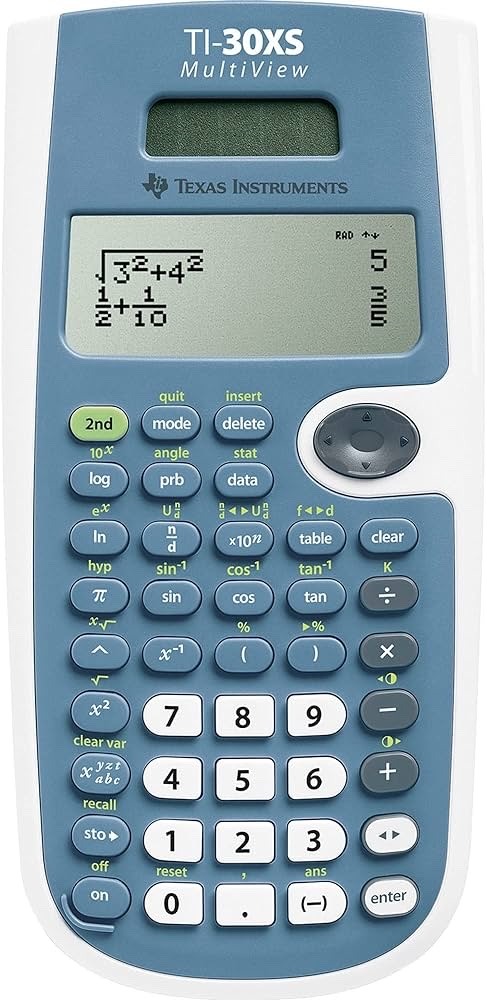
alternatively, the TI-108 is very domesticated. a simple creature. it does not try to be anything more than its primary function, it is honest, it is kind, it will curl up in your lap with a gentle purr. it is the kind of gentle creature you can let your kids play with. it won’t bite. it is like a house pet. like a bird outside your window. let it sniff your hand and it becomes a friendly companion.
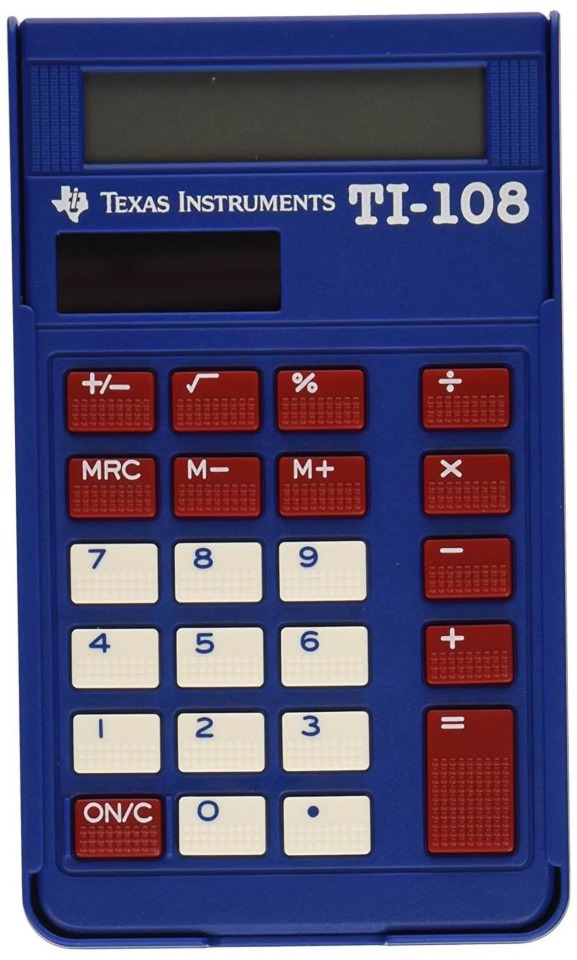
#I don’t fucking know why I wrote this#TI-30XS calculator#TI-108 calculator#mathblr#math#mathematics#textpost#ghgghghhh
16 notes
·
View notes